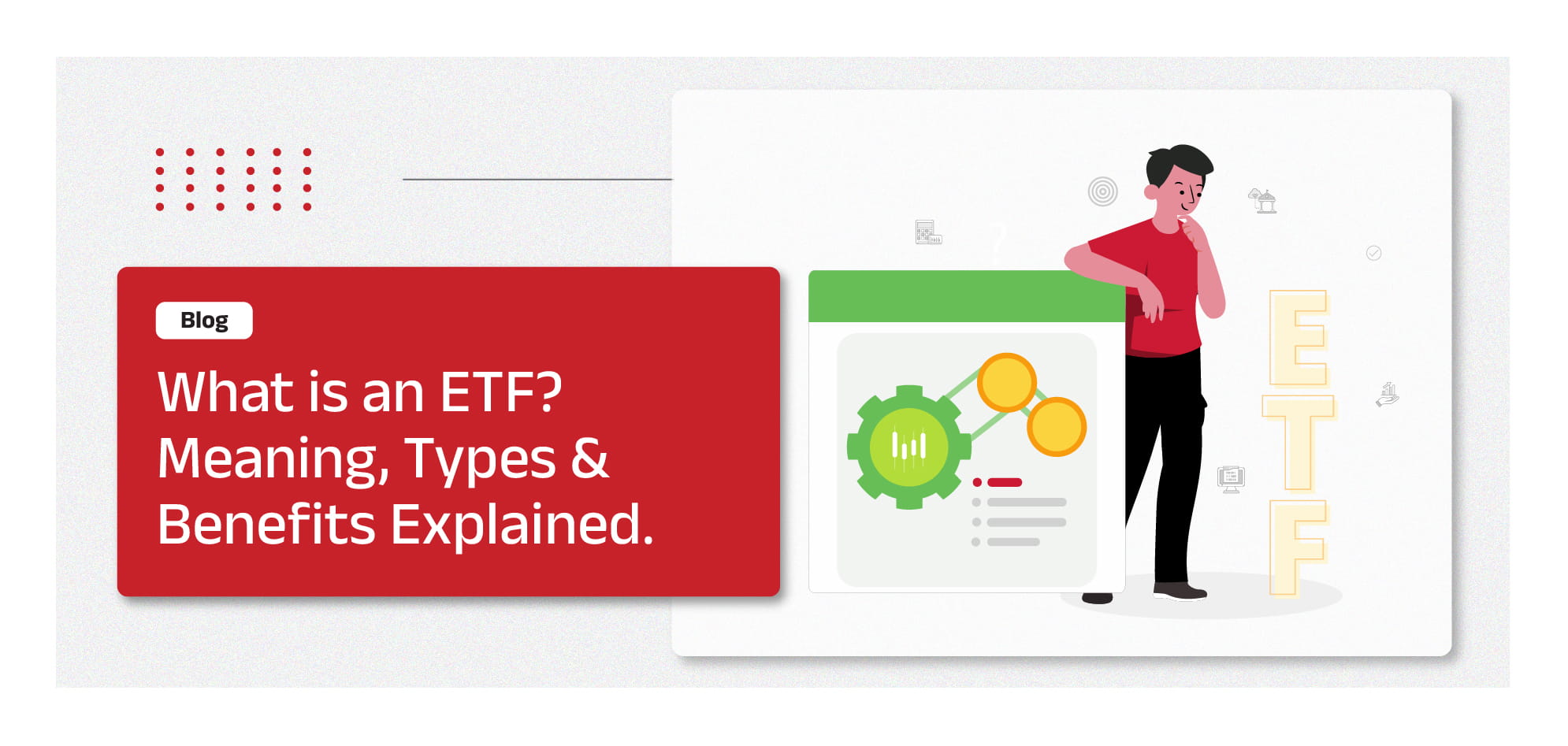-
Our Products
Our FundsFocus Funds
-
Self Care
Self-ServiceFind InformationWays To TransactPartner Solutions
-
Downloads
- Learnings
- About Us
-
More
-
Shareholders
-
Shareholders
-
Updates
-
-
SIP Calculators
- Back
-
Shareholders
What is the Full Form of ETF? Meaning, Types & Benefits Explained

Aug 14, 2025
5 min
0 Rating
The requirement for flexible, transparent, and cost-efficient investment options is the need for every investor. Meeting these requirements and loaded with other worthy features is an Exchange Traded Fund (ETF). It is a smart investment tool that offers diversified exposure to different asset classes. Understanding the ETF full form in the share market and its details is crucial for those entering into index-based investing. Explore the insights into ETFs to be informed and make an accurate, informed decision.
What is the Full Form of ETF?
The full form of ETF in the stock market is Exchange Traded Fund. It refers to a collection of investments that includes bonds, equities, commodities, stocks, and others. ETFs are traded just like individual stocks, with multiple securities in one. They track indexes such as the BSE Sensex, CNX Nifty, and others.
ETFs are cost-effective and offer the merits of mutual funds, such as transparency, diversification, and liquidity. Yet, they differ from mutual funds as they allow buying and selling throughout the trading day at specific prices. Also, unlike mutual funds, the ETFs replicate the performance of the selected index, asset class, commodity, or sector. However, the specific quantity of investments in an ETF varies among individuals depending on the individual's goals and finances.
How Do ETFs Work?
An ETF is created by a fund provider who selects a group of assets like stocks, bonds, or commodities to form a combination that tracks the performance of the underlying asset or index. The fund provider offers shares of this combination to investors, which makes them own a portion of the ETF but not the underlying assets. Investors buy and sell ETF shares on the stock exchange at market prices throughout the trading day.
ETFs do not have an active fund manager making stock selections. Rather, they passively follow the performance of the chosen index or assets. Investors may receive dividends or reinvestments from the ETF if it tracks a stock index that pays dividends.
Types of ETFs
Having understood the ETF full form in the share market and how it works, let’s proceed to the multiple types of ETFs. Here are the insights into the same:
Index ETFs: These types of ETFs track a specific index.
Fixed income ETFs: These ETFs allow investments in different types of available bonds and other debt instruments.
Commodity ETFs: Here, the funds track the price of physical commodities, which can be corn, gold, silver, oil, or others.
Currency ETFs: These ETFs provide exposure to different currencies.
Sector ETFs: These funds target a particular type of industry, such as healthcare or technology.
Inverse ETFs: These funds help gain profit from the decline in the underlying index or market.
Leveraged ETFs: These funds aim to amplify the returns of underlying assets.
Alternative ETFs: These funds let investors get exposure to a particular investing strategy or trade volatility, such as covered call writing or currency carry.
Foreign market ETFs: These funds are related to the non-Indian markets and global indices.
Style ETFs: These funds mimic a specific investment style or market size, which includes large-cap value or small-cap growth.
Thematic ETFs: The investment here is done in emerging trends such as smart technology or Environmental, Social and Governance (ESG).
Key Benefits of Investing in ETFs
ETFs are a widely preferred option due to the following associated benefits:
Liquidity
The ETFs are different from mutual funds in this aspect. While mutual fund require trading at the end of the day, ETFs are open to buying and selling at any time of the trading day. It allows for entry or exit throughout the day.
Diversification
These funds allow investment in a variety of stocks or bonds with a single ETF, allowing portfolio diversification. It also helps in risk mitigation.
Transparency
The daily reporting schedule associated with ETFs adds to their transparent usage.
Cost Effective
The expenses associated with ETFs are comparatively lower than those of actively managed funds.
Flexibility
The ETFs are well-suited for both short-term trading and long-term investing, thus aligning with diverse financial goals.
Tax Efficiency
ETFs offer more tax benefits than actively managed funds. This is because ETFs work by mimicking the performance of a selected index, rather than increasing their value.
Trading Transactions
ETFs allow investors to trade using various order types such as stop-loss orders and limit orders.
How to Invest in ETFs in India
The investment in ETFs should be done with complete consideration. Here is how to proceed for the endeavour:
Identify the investment goals: Assess your financial situation, the risk level you are fine with, the possible investment amount, and the appropriate period of investment.
Evaluate the ETF: Since there are a wide number of options to choose from, ensure proper selection of ETFs as per your requirements. Check the available ETF options based on factors like the assets it encompasses, the expense ratio, liquidity, and track record.
Open a brokerage account: There will be a need for a brokerage account to buy and sell the ETFs. Select the platform for ETF investing that meets your requirements.
Place the order: After you get an ETF account, place the order to buy an ETF. The ETFs can be purchased at the market price or by setting a limit order.
Monitor and adjust: Regular monitoring of the ETFs is recommended to adjust the portfolio as per the needs or a change in market conditions.
Conclusion
For the investors exploring index-based funding, ETFs are considered a preferable option. However, before beginning, it is necessary to have quality insights into ETFs in the stock market and other aspects to make informed decisions. Offering numerous benefits, it has its share of risks as well. Further, a thorough evaluation of available ETF options on necessary features is also essential. Hence, decide accordingly.
The Tax is shown above is for general information only. Investors are advised to consult their Tax Consultant or Financial Advisor to determine tax benefits applicable to them.
The information herein is meant only for general reading purposes and the views being expressed only constitute opinions and therefore cannot be considered as guidelines, recommendations or as a professional guide for the readers. The document has been prepared on the basis of publicly available information, internally developed data and other sources believed to be reliable. Recipients of this information are advised to rely on their own analysis, interpretations & investigations. Readers are also advised to seek independent professional advice in order to arrive at an informed investment decision.
Mutual Fund investments are subject to market risks, read all scheme related documents carefully.
The ETF fund’s full form is Exchange Traded Funds. It is a pooled investment fund that holds a collection of securities and is traded on stock exchanges. ETFs mirror the performance of a specific commodity, index, sector, or asset class.
An ETF provider forms a collection of selected assets, such as bonds, equities, or others, and lists the shares of this combination on the stock exchange. Investors trade these shares during market hours, and ETFs passively track the performance of the chosen index or assets.
There are multiple types of ETFs in India, such as currency, commodity, fixed income, index, thematic, and other ETFs.
ETFs are passively managed and traded on stock exchanges, allowing real-time trading. Mutual fund are actively managed and do not trade throughout the day. The cost and tax implications also vary between the two.
The ETFs come along with a wide range of advantages such as diversification, liquidity, cost-effectiveness, and others. However, there are also certain associated risks, such as market, credit, and liquidity risk.





 1800-270-7000
1800-270-7000



